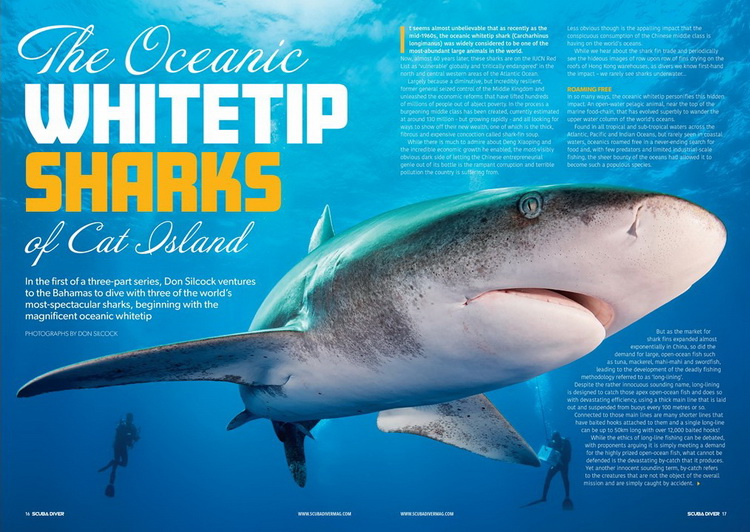Oceanic Whitetip Sharks… It seems almost unbelievable that as recently as the mid-1960’s the Oceanic Whitetip shark, Carcharhinus longimanus, was widely considered to be one of the most abundant large animals in the world.
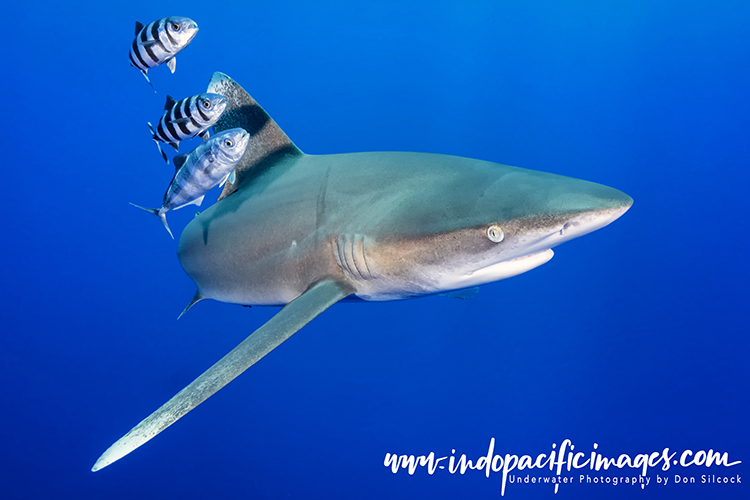
And now, almost 60 years later, these sharks are on the IUCN Red List as “Vulnerable” globally. And “Critically Endangered” in the north and central western areas of the Atlantic Ocean.

Largely because a diminutive, but incredibly resilient, former general seized control of the Middle Kingdom.
Unleashing the economic reforms that have lifted hundreds of millions of people out of abject poverty.
In the process a burgeoning middle class has been created. Currently estimated at around 130m – but growing rapidly…
And all looking for ways to show off their new wealth. One of which is the thick, fibrous and expensive concoction called shark-fin soup.
While there is much to admire about Deng Xiaoping and the incredible economic growth he enabled.
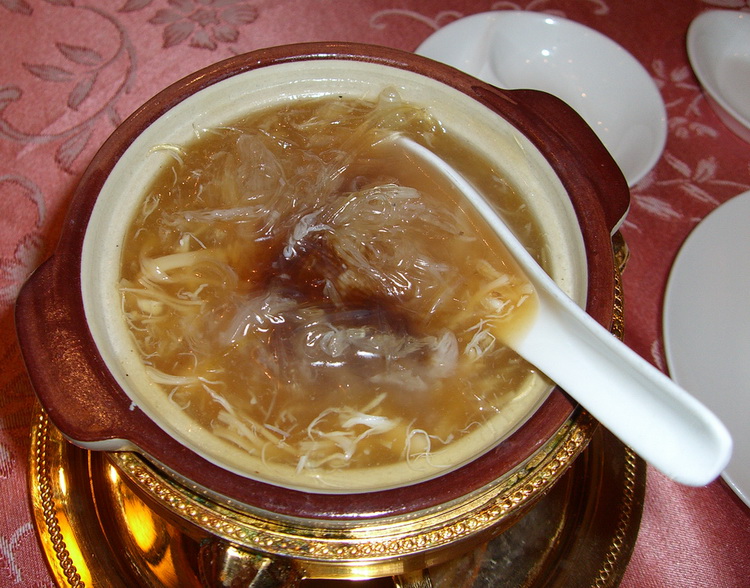
The most visibly obvious dark side of letting the Chinese entrepreneurial genie out of its bottle is the rampant corruption and terrible pollution the country is suffering from.
Less obvious though is the appalling impact that the conspicuous consumption of the Chinese middle class is having on the world’s oceans.
While we hear about the shark fin trade. And periodically see the hideous images of row upon row of fins drying on the roofs of Hong Kong warehouses.
As divers we know first-hand the impact – we rarely see sharks underwater…

Oceanic Whitetip Sharks – Roaming Free
In so many ways the Oceanic Whitetip personifies this hidden impact. An open-water pelagic animal, near the top of the marine food-chain, that has evolved superbly to wander the upper water column of the world’s oceans.
Found in all tropical and sub-tropical waters across the Atlantic, Pacific and Indian Oceans, but rarely seen in coastal waters. Oceanics roamed free in a never-ending search for food. And, with few predators and limited industrial-scale fishing, the sheer bounty of the oceans had allowed it to become such a populous species.
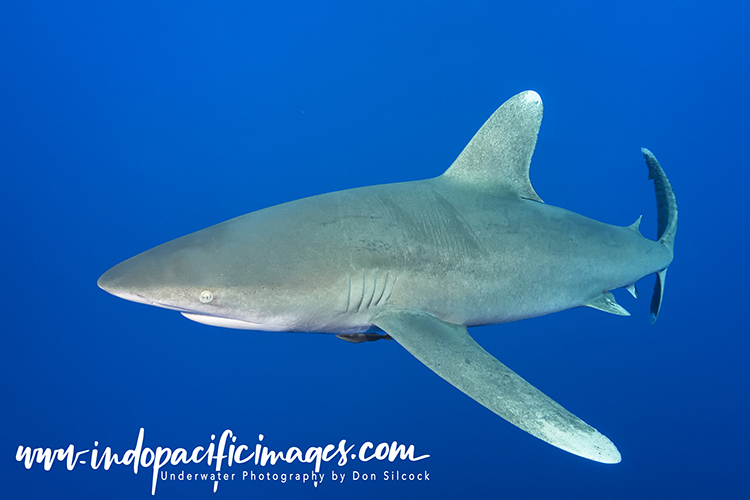
But as the market for shark fins expanded almost exponentially in China. So did the demand for large, open-ocean fish such as tuna, mackerel, mahi-mahi and swordfish… Leading to the development of the deadly fishing methodology referred to as “long-line”.
Despite the rather innocuous sounding name, long-lining is designed to catch those apex open-ocean fish. And it does so with devastating efficiency using a thick main line that is laid out and suspended from buoys every 100m or so.
Connected to those main lines are many shorter lines. Which have baited hooks attached to them and a single long-line can be up to 50km long with over 12,000 baited hooks!

While the ethics of long-line fishing can be debated. With proponents arguing it is simply meeting a demand for the highly prized open-ocean fish… What cannot be defended is the devastating “by-catch” that it produces.
Yet another innocent sounding term. By-catch refers to the creatures that are not the object of the overall mission and are simply caught by accident.
Oceanic Whitetip Sharks as By-Catch
Oceanics spend the vast majority of their time roaming in what scientists call the “surface mixed layer” of the water column. Which in layman’s terms means from the surface down to about 150m.
This is basically their domain and where they are the apex predator. Traveling slowly but efficiently over great distances with their large, almost winglike pectoral fins. Longimanus is roughly translated as “long hands” in reference to those fins.
In that mixed layer are the tuna, barracuda, swordfish and white marlin that are the Oceanic’s principal source of food. But it is also where the long-lining fishing boats concentrate much of the effort.
As they are such opportunistic feeders, Oceanics are drawn on to the “line of death” in astonishing numbers. With very clear indications that it has caused population declines of at least 70–80% in all three ocean basins.
Oceanic Whitetip sharks are not specifically targeted by the long-liners. But they provide a lucrative sideline as their large and distinctive fins are highly prized in the international fin trade.

Size matters to the Chinese and the fact that the key ingredient in the trophy soup served at banquets and weddings comes from an apex predator, carries a very special cachet to the increasingly status conscious middle class.
The really appalling aspect of Oceanic by-catch though, is that because their meat is considered as low value. The sharks are usually separated from their prized appendages and then thrown back in to the water to drown!
This hideous practice has gone on for many years. And while there are signs it is now changing in the regulated areas such as the U.S. Northwest Atlantic. There is little doubt that it continues unabated in less controlled areas.
Hope Springs Eternal…
While it is far too early to declare, or even consider declaring, any kind of victory in the journey to reverse the population decline of Oceanic Whitetip sharks. There is cause for a degree of optimism.

Two main things have brought this about, starting with the recruitment of prominent Chinese celebrities.
Such as former Houston Rockets basketball star Yao Ming to the WildAid campaign of raising awareness of the impact of eating shark fin soup.
The fame that the 7.5-foot-tall Yao Ming gained in the USA has made him a mega-star in China. So the credibility he brings to the campaign is simply immense!
When WildAid began its campaign in 2006, their research showed that 75% of the Chinese surveyed were unaware that shark fin soup actually involved sharks because the Mandarin translation is “fish wing soup…”
Furthermore, about 19% of those surveyed believed that the fins actually grew back again!
Yao Ming’s commitment to the campaign has had a huge impact! And it is said that eating shark fin soup is now almost shameful for young middle-class people. Which is an incredibly positive development, but in a country of 1.3 billion people and a middle-class of 130m it is obviously just a drop in the ocean.
Government Level Awareness
More significantly perhaps, is the way the Chinese government is getting behind certain aspects of conservation and specifically the shark fin campaign. Whether that is because they really care or are simply using it as way of improving the generally tarnished global reputation of China is impossible to know.
But the actions taken so far are very positive. Such as closing shark fin speciality restaurants in major cities such as Shanghai and Beijing. Plus making it illegal to consume the soup at all official banquets.
Studies of the global shark fin trade indicate that the market is in fact declining. So while there remains much to do, it would appear that the lowest point may be behind us.
Underwater Encounters
Until recently the Red Sea was generally considered as the best place to see and photograph Oceanic Whitetips. Typically in remote locations such as the Brother Islands and Elphinstone Reef in Egypt or the isolated reefs of southern Sudan.

Significantly though, these sightings are generally of lone individuals or very small groups. And little is known about the overall population of Oceanics in the Red Sea or their migration patterns.
Oceanic Whitetips are formidable animals that can reach almost 4m in length when fully mature and have a reputation to match their size… With Jacques Cousteau once describing them as “the most dangerous of all sharks”.
When encountered underwater they have an intimidating presence and are very inquisitive. Seeming to have no fear whatsoever – a combination that comes over as naked aggression when first experienced.
They will come in very close and even bump you – often repeatedly. Which is obviously quite disconcerting to the uninitiated… But it seems that this is simply their way of checking you out.
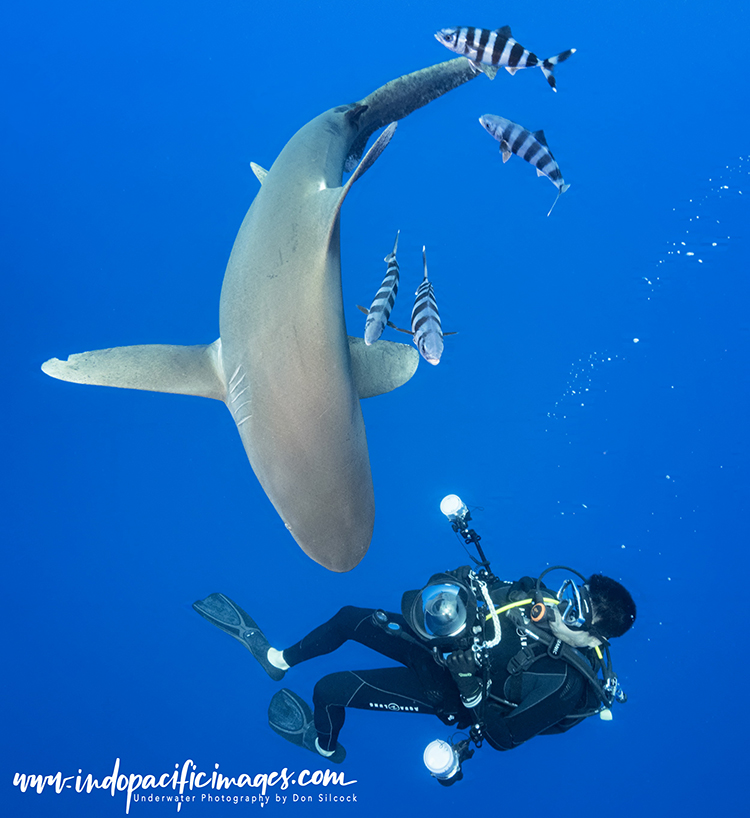
Cat Island
Once a common sight in the deep offshore waters around the Bahamas. From around the early 1980’s Oceanic Whitetip sharks became increasingly rare. And it was generally assumed they had been completely cleared out by long-lining.
Although it seemed much too late for the Oceanics, as part of their overall conservation program, the Bahamian government banned long-lining completely in the early 1990’s.
Then around 2005 the fishing community at Cat Island started to complain about sharks stealing their catches… Behaviour that Oceanics are renowned for, but it was another year before it became clear that something quite special was happening!
Cat Island is a long, thin island that is in the middle of the Bahamian archipelago. On the eastern boundary of the main limestone carbonate platform called the Great Bahama Bank.
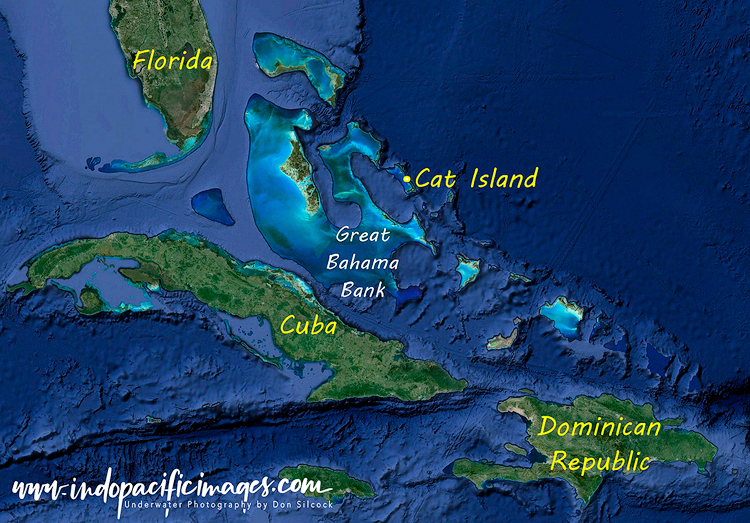
Its eastern and southern shores sit right on the edge of that bank. And just offshore are the deep blue waters of the western Atlantic Ocean Basin and the rich Antilles Current that sweeps up the coast as it heads north.
It is a perfect location to fish for large ocean-open pelagic fish like marlin and tuna. Exactly why the fishermen were there… But it’s also the perfect spot for Oceanic Whitetips to reappear again after their enforced absence!
Quite who made the discovery is not clear. As it seems both a BBC film crew and National Geographic photographer Brian Skerry were there about the same time, both following up on the same lead.
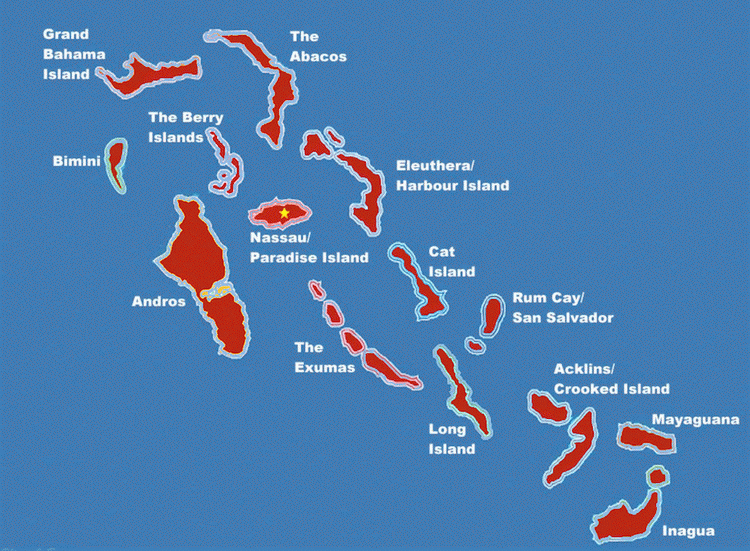
A Significant Discovery!
The significance of the discovery though is incredibly important. Because there on the south-eastern tip of Cat Island was what appeared to be a healthy population of Oceanic Whitetips. Almost completely opposite to what was happening everywhere else in the world, where declines of 80-90% had become the norm.
It also provided the first opportunity anywhere for scientists to tag Whitetips. And track their movement patterns to try and understand why they were recovering. Lessons that could be applied elsewhere!
Serious research began in 2010 and since then some 100+ Oceanics have been tagged with satellite tracking devices. Several important results have come to light so far. Starting with the fact that while the tagged sharks roamed far and wide in the Atlantic. In some cases up to 2000km away from Cat Island. But overall, they spent most of the year in the protected waters of the Bahamas.
Probably the two most significant results however are that over time it has become apparent that the overall population of Oceanic Whitetips at Cat Island may be as low as 300.
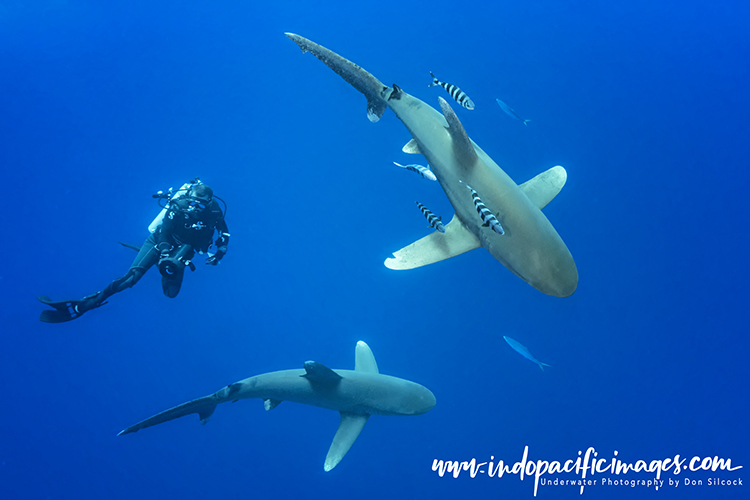
And secondly, while many of the sharks are pregnant females. There are no indications that they give birth at Cat Island, so the challenge now is to find the birthing grounds and establish a full cycle of protection.
There are indications that the north coast of Cuba may hold the secret to this. As government scientists there have reported significant numbers of juvenile Oceanic Whitetips off from the small village of Cojímar!
Cat Island Oceanic Whitetip Sharks – Encounters
Over the last 5-6 years the Bahamas has firmly established itself as the “shark diving capital of the world”. Largely because of the Tiger and Lemon shark encounters at Tiger Beach on Grand Bahama and those with the Great Hammerheads at Bimini.
Those encounters are what I would describe as a two-dimensional experience. Where you are typically kneeling on a sandy area in shallow water and the sharks usually approach you from the front.
So, it is all reasonably predictable and relatively easy for the support divers to literally “watch your back”.
Cat Island however is very much a three-dimensional experience. Because you are in blue water and your only point of reference is the white bait crate that is suspended at about 10m.

The Oceanics are attracted by the bait, but are not actually fed as the mere scent seems to be enough to keep them engaged… And engaged they truly are, exhibiting no apparent fear and approaching extremely close. Often to the point of bumping your dome port!
They also sneak up from behind, above and below, often coming so close that they touch you with those long fins… As exciting as all that is, I never really felt in any real danger. As it all seems part of their pattern of testing to see if you are the weakest link and worthy of further investigation!
Cat Island Oceanic Whitetip Sharks – How It Works…
Options to dive with the Oceanic Whitetips at Cat Island are somewhat limited. As the season is short, from the end of March to mid-June. Plus the island lacks much of the tourism infrastructure of the more popular locations in the Bahamas.
I booked my trip with Andy Murch of Big Fish Expeditions (I paid full price….). And he worked with Epic Diving who base themselves and their boat MW Thresher at Cat Island during the Oceanic season.
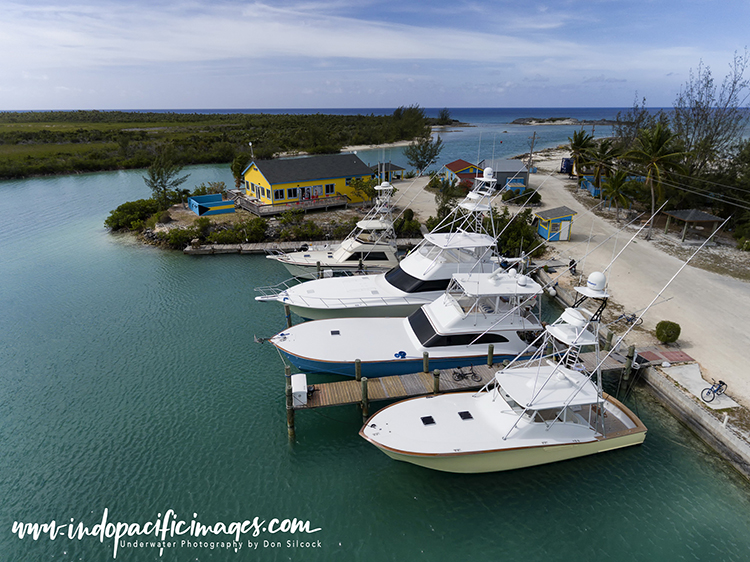
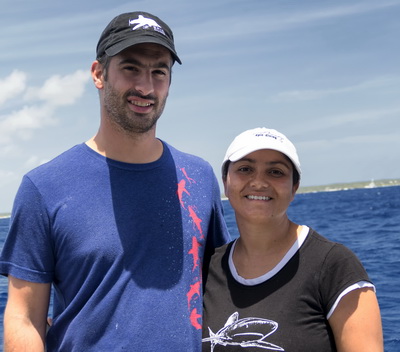
Run by husband-and-wife team Vincent and Debra Canabal – Epic’s story is well worth telling!
As they both put their professional careers on hold to pursue their shared passion for sharks, shark diving and shark conservation.
In Vinnie’s case that was being a hospitable emergency-room physician in New Jersey. Something he still does in the off-season…
While Debra worked as an animal nutritionist after completing a Ph.D. in Biomedical Science.
Cat Island Oceanic Whitetip Sharks – The Last Place…
The Bahamas was one of the first countries to understand the importance of sharks to their seas and fish stocks. Plus the growth of shark tourism has proven that live ones are much more valuable than the dead and de-finned variety!
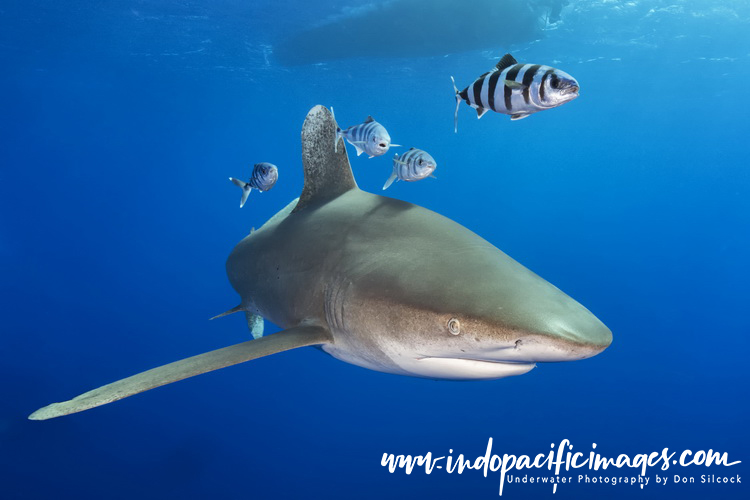 The establishment of the Bahamas National Trust in 1959 to manage the world’s first marine protected area. The 112,640 acre Exuma Cays Land & Sea Park, can now be viewed as an incredible piece of foresight!
The establishment of the Bahamas National Trust in 1959 to manage the world’s first marine protected area. The 112,640 acre Exuma Cays Land & Sea Park, can now be viewed as an incredible piece of foresight!
The Bahamas have since added another 26 national parks covering over 1 million acres of land and sea. Then in 2011 the government went one step further and became the 4th country in the world to establish a shark sanctuary by formally protected all sharks in Bahamian waters.
It seems clear that the reappearance of a small, but healthy population of Oceanic Whitetips at Cat Island would never have happened if the government had not taken those measures!
Nature is an amazing thing that can produce astonishing things if we humans can only give it the chance to do so…
Cat Island Oceanic Whitetip Sharks – Scuba Diver Article
The UK version of ScubaDiver magazine recently published an extensive six-page article of mine on Cat Island. You can use this link to download the The Oceanic Whitetip Sharks of Cat Island article in PDF format.
